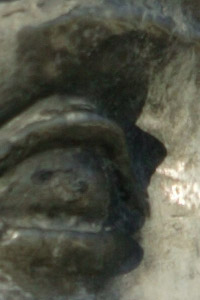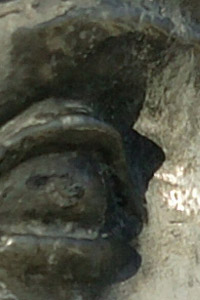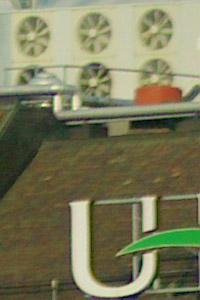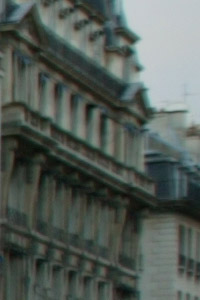 "Best in Show," 2004 PMA - DxO Photo Pro (Exclusive sample images.)
"Best in Show," 2004 PMA - DxO Photo Pro (Exclusive sample images.)
By
Dave Etchells, The Imaging Resource
(Tuesday, February 17, 2004 - 19:56 EST)
Every year after the PMA show, people always ask me what I thought was the most interesting/exciting product I saw there. This year, the easy answer is DO Labs' DxO Photo Pro software, an amazingly powerful tool/technology for correcting optical distortion and artifacts in digicam images.
DO Labs, maker of DxO Optics Pro, issued a press release on the software prior to PMA (see below), but I've been waiting to report on it until (a) I could see the results it produced personally, and (b) I had time to devote the attention to it that I felt it deserved.
Based on a telephone/web briefing I had with DO Labs prior to PMA, I'd been expecting to see noticeable but subtle improvements in image quality when DxO Optics Pro was applied to typical digicam images. When I finally had a chance to squint at before/after image samples myself though, I was amazed by the degree of improvement it offered. What particularly surprised me was how much it enhanced even images that had been shot with very high-quality lenses. The improvements were far from subtle, but instead were obvious, I'd in many cases go so far as to call them dramatic.
Most exciting though, was how thoroughly the software appeared to be able to correct softness, distortion, and chromatic aberration in images from very inexpensive lenses, which showed rather poor image quality to begin with. Bottom line, the corrected results from a $200-300 zoom lens easily surpassed the uncorrected results from a $1500-1700 one.
This is why I picked DxO Optics Pro as the most significant product shown at PMA 2004. The technology could easily be embedded within a digicam's firmware, resulting in dramatic improvements in image quality, even with very inexpensive optics. It promises to raise the bar for image quality standards, while simultaneously allowing manufacturers to reduce manufacturing costs for their optics. More than any other product I've seen, it has the potential to impact the entire digital imaging industry, and in a relatively short time frame, too.
Before I get into the details of how DxO works, let's take a look at some of the results DO Labs has achieved with it. - All the images below were captured with a Canon EOS-1Ds, using the lenses indicated. None of the full-sized images have been manipulated in any way by myself, they're exactly as I received them from DO Labs. (To the best of my knowledge, this is the first time that these images have been shown on the web, as they haven't yet even been uploaded to DO Labs' own web site.)
Click on any image to view/download the full-sized version, but do be considerate of my bandwidth, as these are large image files.
Canon 24-70mm f/2.8 L USM, on Canon EOS-1Ds
70mm focal length, f/4.5, 1/640, at ISO 100
|

|

|
|
This image has no edge detail due to the shallow depth of field, but is a good example of the improvement in center sharpness than can be achieved, even when you begin with a high-quality lens. |
There's a little vignetting correction visible here, and a slight scale change that results from correcting the barrel distortion. The primary effect though, is a fairly dramatic increase in center sharpness. |

|

|
|
The original image is quite clean, but somewhat soft-looking. |
After correction, the final result is much sharper. Particularly notable is the complete lack of sharpening-related artifacts. (Halos/borders, etc.) |
|
|
Tamron 70-300mm f/4.5-5.6, on Canon EOS-1Ds
200mm focal length, f/4.5, 1/1000, at ISO 100
|

|

|
|
This shot was captured with a much less expensive lens. Here, vignetting is much more evident inn the sides and corners of the original. |
The corrected image looks brighter overall, but that's simply the result of the vignetting correction: The center of the corrected image is within 0.5% the brightness of the original. |

|

|
|
The original crop from the upper right hand corner of the image was a good bit darker than this, due to the heavy vignetting in the corners of the frame. I adjusted the tonal balance in Photoshop, so it would be easier to compare with the corrected version at right. Note the combination of geometric distortion in the shape of the fan housings, and the letter "U", the fuzziness, and the fairly strong chromatic aberration around the edges of the letters. |
The corrected version is markedly sharper, and the various distortions have been largely corrected. The fan housings show more of a proper shape (given the perspective), the large "U" is more correctly proportioned, and the chromatic aberration has all but vanished. Very impressive! |

|

|
|
Here's a crop from closer to the center of the image, towards the bottom edge. Here, there's no obvious distortion or aberration, but the image is noticeably soft. |
The corrected version is much sharper, again with few or no visible sharpening artifacts. (I do see a slight halo here, particularly around the man's head, but it's only about a pixel wide, and not too strong.) Although there wasn't any obvious distortion in the original crop, we can see that the "after" version has been warped somewhat, the result of correcting the lens' pincushion distortion. |
|
|
Sigma 17-35mm f/2.8 EX Aspherical, on Canon EOS-1Ds
17mm, f/2.8, 1/125, at ISO 100
|

|

|
|
This image shows vignetting and corner softness more strongly than the previous ones. (As you would expect, from a super-wide zoom lens.) There's also more barrel distortion, although the positioning of the scene elements doesn't call particular attention to it. |
The corrected image is considerably brighter in the corners, due to the vignetting compensation, and is much sharper overall. - But the chromatic aberration isn't as completely corrected as we saw in the previous examples. (FWIW, I think there was also a slight amount of blurring from camera shake present here, that obviously can't be corrected for by the software, without a reference for the specific blur function.) |

|

|
|
Here's a crop from near the center of the image, toward the bottom. |
The correction here is pretty typical of what we saw above. |

|

|
|
This is an example from near the right hand edge of the image, showing quite a bit of blurring. |
This time, DxO Optics Pro isn't quite as successful at de-blurring the image. Also, while I haven't shown an example of it, there are some places on the opposite side of the frame, in which it appears that Optics Pro couldn't completely eliminate the chromatic aberration either. |
The results shown above really speak for themselves - There's no question that DxO Optics Pro results in dramatic improvements in image quality across the board, whether you're working with an expensive lens or a cheap one.
So how do they do it?
It all starts with an exhaustive profiling of the performance of the entire imaging chain, including the lens, the sensor, and the processing electronics. Working from images of a grid of precisely-placed black dots on a white field, DO Labs maps the performance of the imaging chain across the entire frame, at a range of focal lengths, apertures, and focal distances. The results of literally hundreds of tests are distilled down to a multi-coordinate mathematical representation of the optical system's performance, incorporating blur and distortion characteristics across the entire image frame, for each of the red, green, and blue channels, at each of a range of focal lengths and aperture settings.
By applying the inverse mathematical functions for the various distortion components found during the analysis process, DxO Optics Pro can reverse the optical distortion to a surprising degree.
All this comes at a price though, in that the process of fully characterizing an imaging system is complex and exceedingly time-consuming. - DO Labs told me at PMA that it can take as much as two weeks of continuous work to capture and process all the test data required to fully characterize the distortion field of a single camera or lens. It's thus unclear how quickly the DxO technology can in fact be rolled out across the industry, given the vast range of lens/camera combinations that are out there. (But it could start appearing on a case-by-case basis fairly quickly.)
Given the magnitude of the task and the unprecedented nature of the product, it seems that DO Labs themselves are a little uncertain of how best to implement and price it. Particularly in the early going, they need to focus their efforts on whatever areas are most likely to produce the best revenue, but there's no simple way of knowing what those areas might be. (More expensive sets of correction factors for high-end SLRs and the most common removable lenses? Or less expensive solutions for more prosumer cameras sold in higher volumes?) One of the most obvious applications for the technology would be for manufacturers to incorporate it directly into their digicams, but that could take a fair while to implement, given the length of digicam development cycles.
As of this writing then, there's no commercial product available that implements the DxO Photo Pro technology, but DO Labs has announced that they plan versions by March to support most digital SLRs, including the Canon 1Ds, 1D, 1D Mark II, 10D, D60, and Digital Rebel, the Nikon D100, D1x, D2H, and D70, the Fujifilm S2 Pro, Olympus E-1, Pentax *istD, and Kodak Pro 14n cameras, "with a selection of manufacturer-branded and compatible lenses." - And therein lies the real question: "How many lenses, and which ones?" Time will tell, we should know more fairly soon.
Regardless of how many camera/lens profiles are rolled out how quickly, there's no question that this technology could have a greater impact on image quality across the entire industry than any other single development we've seen in the last several years.
Overall, this is definitely a technology to watch: Any digicam manufacturer that manages to incorporate it into their camera designs ahead of the others is going to have an immediate and dramatic advantage over their competition. - And if it comes to market in the form of end-user software for specific camera models (assuming, of course, that it does so at a reasonable price), it could amount to one of the most worthwhile investments a camera owner could make, in the name of improved image quality. Stay tuned, we'll be sure to keep our readers posted on any developments with this exciting technology!
|
Original Source Press Release:
|
DO LABS INTRODUCES DXO(r) OPTICS PRO(tm)
Breakthrough Software Application for Digital SLR Camera Users Eliminates Blur, Distortion, Chromatic Aberration And Vignetting
Las Vegas, NV (February 12, 2004) –
DO Labs
, a software company focused on research in image processing to enhance image quality, today announces
DxO Optics Pro
, a revolutionary software solution designed for professional and expert photographers. DxO Optics Pro delivers genuine and perceptible quality improvements by automatically correcting images for:
-
Distortion
-
Chromatic aberrations
-
Vignetting
-
Blur (lack of perceived sharpness)
“Isn’t it frustrating that the more you pay for high-end digital cameras or lenses, the more you feel their limitations?” asks Jerome Meniere, CEO of DO Labs. “The brighter a lens, the softer it is wide open, the wider the range of a zoom lens, the greater the distortion, the higher resolution the sensor is, the more visible chromatic aberration becomes. DxO Optics PRO will help demanding photographers get the best possible image quality from their equipment, at any settings.”
“DxO Optics Pro can be thought of as a ‘software corrective lens’ for your DSLR,” explains Dr. Frederic Guichard, DO Labs’ Chief Scientist. “We have created objective, laboratory-grade precise mathematical models of each fault, and developed fully automatic algorithms to remedy them.”
DxO Optics Pro benefits
Push optics and lenses to a new level of performance:
With DxO Optics Pro, even very high end lenses benefit from perceptible improvement in image quality. The best lenses become even better. Of course, images shot with mid-range or entry level lenses experience an even greater leap in quality.
Maximize performance under extreme conditions:
Using DxO Optics Pro, photographers are able to dramatically improve the performance of their lenses in critical aperture or focal settings. For example, it is now possible to shoot wide open and yet get tack-sharp images.
Easily integrates into workflow:
Because DxO Optics Pro is both automatic and fast, it will integrate seamlessly into a photographer’s workflow. DxO Optics Pro correction will typically precede any other correction applied to the image in typical photo retouching software such as Adobe Photoshop.
DxO Optics Pro correction characteristics
-
DxO Optics Pro corrections are objective and ‘real’, for they are calculated based on a physical characterization of the optical system. DxO Optics Pro image correction relies on a physical model called a DxO Profile, which is specific to each lens and camera model used.
-
DxO Optics Pro corrections are fully automatic: no settings, no manual user intervention at any stage. This allows for seamless batch processing of images and will be a huge time saver for all photographers.
-
DxO Optics corrections have a laboratory-grade precision: Each DxO profile benefits from DO Labs’ expertise in optical phenomena measurements. For example, distortion can be lowered below a residual 0.02%.
-
DxO Optics Pro corrections operate locally, on each pixel: Optical flaws impact each point of the image differently – so DxO Optics Pro adapts the correction to each pixel in the image.
-
DxO Optics Pro corrects complex faults: DxO Optics Pro can correct irregular, variable aberrations. For example, the correction of blur accounts for complex phenomena such as astigmatism.
-
DxO Optics Pro automatically integrates relevant capture settings (i.e. aperture, focal length, focus distance, etc.): DxO Optics Pro uses EXIF data to fine tune the correction to the exact shooting conditions.
-
DxO Optics Pro corrections are fast: With performances above 2 Mpixel/second , DxO Optics PRO can correct in seconds even large images produced by the highest quality DSLRs.
Availability and pricing
DxO Optics Pro software solution consists of two elements:
i. the DxO Optics Pro Correction Engine which is a standalone Macintosh or Windows based application; and
ii. a set of DxO Profiles characterizing the optical properties of body/lens combinations.
The DxO Optics Pro Engine will be available for Windows and Macintosh platform:
- in March 2004 in JPEG/8bit mode; and
- in May 2004 in RAW/16bit mode.
DO Labs plans to offer DxO Profiles for all significant professional and prosumer digital camera bodies and lenses. The first DxO Profiles available (JPEG/8bit mode) will include:
-
Canon EOS 1Ds, Canon EOS 1D, Canon EOS 1D Mark II, Canon EOS 10D, Canon EOS D60, Canon Digital Rebel (300D) with a selection of Canon branded and Canon compatible lenses;
-
Nikon D100, Nikon D1x, Nikon D2H, Nikon D70 with a selection of Nikon branded and Nikon compatible lenses;
-
Fuji S2Pro, Olympus E-1, Pentax *ist D, Kodak DCS Pro 14n with relevant own-brand or compatible lenses;
New DxO Profiles will be released on an on-going basis and DO Labs will run a ‘DxO Profile – request survey’ on its Web site to collect the most popular requests for DxO Profiles.
All DxO Optics Pro components will be available on DO Labs’ e-commerce store, which can be reached via
www.DxOPRO.com
. Pricing to be announced.
About DO Labs and its DxO Technology
DO Labs SA is a software company focused on research in applied mathematics for digital image enhancement. The roots of the company come out of the most advanced academic mathematical research with strong ties to leading universities and research labs and a prestigious Scientific Committee.
The company’s patented DxO technology produces genuine, perceptible improvements in the quality of any digital image. DxO is a set of software components that measures and corrects major faults found in imaging devices: Blur, Local Contrast, Distortion, Vignetting, Chromatic aberration, Jpeg artifacts, etc. Furthermore, DxO Correction offers key benefits that makes it an industrial-grade solution:
-
DxO produces optimum image correction;
-
DxO is robust: DxO will never damage image quality;
-
DxO is automatic: No human intervention is required at any stage;
-
DxO is real time: it can be easily embedded in any real-time workflow (ARM, DSP, ASIC) inside imaging devices such as digital still cameras or camera phones; in a PC at driver level, a server; or in a digital photofinishing minilab equipment.
For more information, visit DO Labs online at
www.dolabs.com
.
|
Powered by
Coranto
|